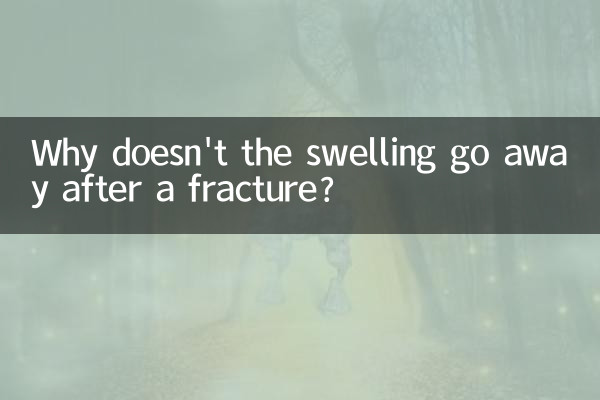Why doesn't the swelling go away after a fracture? ——Cause analysis and response guide
Swelling after a fracture is a common phenomenon, but if it persists and does not subside, it should be taken seriously. This article combines the hot topics in the medical and health field on the Internet in the past 10 days to sort out the common causes, countermeasures and precautions of fracture swelling to help patients deal with it scientifically.
1. Common causes of swelling after fracture (statistics)

| Cause classification | Specific performance | Proportion (reference) |
|---|---|---|
| inflammatory response | Increased local vascular permeability after trauma | 35%-45% |
| Improper fixation | Cast/brace is too tight or displaced | 20%-25% |
| venous return disorder | Insufficient physical activity leads to congestion | 15%-20% |
| Infect | Redness and swelling of the wound accompanied by fever | 5%-10% |
| Other complications | Thrombosis, compartment syndrome, etc. | 3%-5% |
2. Recent hot related topics
1. #diet taboos during fracture recovery period (hot search on Douyin)
2. Is the # swelling artifact really effective (hot discussion on Xiaohongshu)
3. #TCM acupuncture-assisted swelling case sharing (Weibo Health List)
3. Five major measures to scientifically reduce swelling
1. Raise the affected limb
Keep the affected limb above the level of the heart every day, and it is recommended to use pillows to elevate it for more than 30 minutes each time.
2. Alternating hot and cold therapy
In the early stage (within 48 hours), use ice compresses for 15 minutes each time; later on, use hot compresses to promote blood circulation.
3. Medication assistance
| drug type | Representative medicine | Note on usage |
|---|---|---|
| Oral anti-inflammatories | ibuprofen | Take after meal |
| topical ointment | diclofenac sodium gel | Avoid broken skin |
| Chinese patent medicine for promoting blood circulation and removing blood stasis | Yunnan Baiyao Capsules | Avoid spicy food |
4. Rehabilitation training
Perform progressive activities such as ankle pumps (3 sets of 20 times daily) under your doctor's supervision.
5. Nutritional supplements
Increase protein (1.2-1.5g/kg body weight per day) and vitamin C (500mg per day) intake.
4. Danger signs to be wary of
• Swelling accompanied by severe pain or numbness
• Purple/darkened skin
• Body temperature consistently higher than 38°C
• No reduction in swelling after 3 weeks
5. TOP3 effective methods for reducing swelling tested by netizens
| method | support rate | Things to note |
|---|---|---|
| Traditional Chinese medicine fumigation (mugwort leaves + safflower) | 72% | Need to be used after the fracture is stabilized |
| low frequency pulse electrotherapy | 65% | Avoid metal internal fixation parts |
| Ultrasound therapy | 58% | Requires professional physician operation |
6. Expert advice
Professor Wang Qiang, director of the Department of Orthopedics at Beijing Jishuitan Hospital, emphasized in a recent health live broadcast:
"After the fracture, if the swelling does not relieve for more than 2 weeks, X-rays need to be reviewed promptly to rule out the possibility of dislocation. Diabetic patients and smokers are more likely to experience delayed swelling."
7. Reference for recovery time
| fracture type | normal swelling cycle | full recovery time |
|---|---|---|
| broken finger | 1-2 weeks | 4-6 weeks |
| distal radius fracture | 2-3 weeks | 6-8 weeks |
| tibia fracture | 3-4 weeks | 3-6 months |
Warm reminder: Individuals vary greatly. The data in this article are for reference only. Please follow your doctor’s advice for specific treatment plans. Recent hot searches show that #rehabilitation exercise video has over 100 million clicks. It is recommended to carry out rehabilitation training under the guidance of professionals.

check the details

check the details